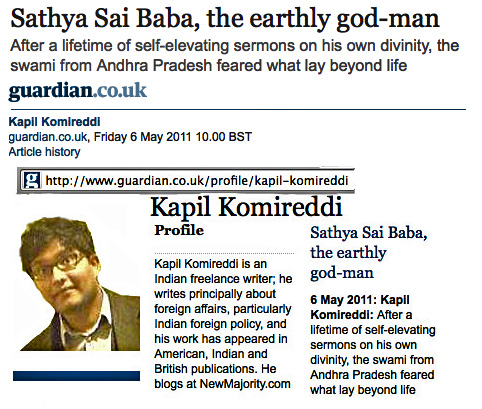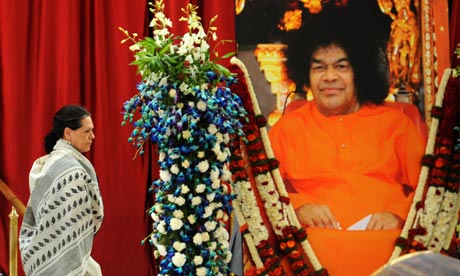Sathya Sai Baba was unusual among India's grotesquely obese multitude of god-men. He was born in southern India in 1926. At the age of 14, according to his army of hagiographers, he had an epiphany: declaring himself a reincarnation of the 19th-century Marathi Sufi savant Sai Baba, he dropped his given name, Sathyanarayana Raju, and began calling himself Sathya Sai Baba. By the time of India's independence, Sathya Sai Baba was 20. But the man claiming to possess cosmic knowledge does not appear even on the margins of independent India's early history.
Southern India in the early decades of India's independence was a place of extraordinary social reform and radical political experimentation. Independent India's first linguistic state, Andhra Pradesh, was created in the south, and a democratically elected communist government appeared further down in Kerala. The new secular dispensation threatened the entrenched structure of Hindu society. Sathya Sai Baba does not figure anywhere in the many debates and movements of this time.
The countercultural movement of the 1960s in the west transformed neglected Indian sadhus into global gurus. Mahesh Varma became, briefly, a spiritual guide to the Beatles. The Bengali Vaishnavite Prabhupada found his early western converts during this time. But Sathya Sai Baba, stationed in distant Puttaparthi, away from the spiritual bazaars of Varanasi and Rishikesh, attracted only a small segment of the hippies who travelled to India. Almost all of them had heard about him from others, and virtually none of them knew what he looked like.
Unlike the Sufi Sai Baba, Sathya Sai Babai's message was banal: there was an emphasis on vegetarianism, love and peace, but no radical insights into the condition of humanity. Nor was he in the business of converting people. Instead, in a novel touch, he urged his followers to be good practitioners of their own faith. But what made him distinct was his uniquely arresting appearance: the flowing saffron robes, the tiny body, and the woollen hair, resembling a topiary bush, that sat above his childlike face. His intellectual limitations were more than compensated for by thaumaturgy, his principal strength, and he cultivated his devotees with impressive gifts conjured from the air.
Until the 1990s, Sathya Sai Baba's influence rarely extended beyond his circle of followers. Within his own home state of Andhra Pradesh, he was rubbished as a charlatan by the charismatic and wildly popular film star-turned-politician NT Rama Rao. But when PV Narasimha Rao, a fellow Andhrite, became prime minister in 1991, it consecrated Sathya Sai Baba's position as the most powerful god-man in India.
There are riveting accounts by devotees of encounters with Sathya Sai Baba. One westerner records being handed a "freshly glazed" photograph, produced in the swami's palm as if by magic, with the address of his ashram on the back. "You've been asking for my address," Sathya Sai Baba tells him. "Here it is. Keep it in your wallet." There are numerous tales of patients beings healed by the swami's sacred ash. In one of the more fantastic tales, the swami is approached by a terminally ill woman; her only hope of survival is a treatment that is available exclusively in Japan, but she does not have the means to travel. The swami smiles, points to a door and asks her to open it. She does. On the other side is Japan.
Sathya Sai Baba preferred earthly modes of transport for himself, travelling in a Rolls-Royce gifted to him by a wealthy devotee. The Sufi Sai Baba had lived in a dilapidated mosque; his supposed reincarnation's "humble" ashram was a veritable palace. For a man claiming to be god, Sathya Sai Baba was oddly enthusiastic about science; perhaps it had something to do with his own mastery of the laws of physics. He collected vast sums of money to build super-speciality hospitals – although no one bothered to ask him why, as god, he would not make hospitals redundant by eradicating disease altogether.
To Sathya Sai Baba's great credit, he condemned the destruction of the Babri mosque in 1992 and, despite blandishments by the Hindu right, always refused to endorse their project. But proximity to power brought its own benefits. In 1993, four men entered the swami's bedroom carrying knives; they were confronted by the police guard, overwhelmed, sealed up in a room, and then shot dead. The then home secretary of Andhra Pradesh described the killings as "cold blooded murder". But investigations never followed.
Reports of sexual misconduct were similarly ignored. At least two young men accused the swami of putting his penis in their mouths. In 2001, India's first Hindu nationalist prime minister, Atal Bihari Vajpayee, circulated a letter on his official notepaper condemning the allegations as "concocted".
Ultimately, Sathya Sai Baba's protracted struggle to avert death demonstrated that, even as a human, he was merely ordinary. After a lifetime of self-elevating sermons on his own divinity, he feared what lay beyond life – and he feared it so severely that he ceased to be concerned by the gulf it opened up between image and reality. God spent his final days on a life-support system.

